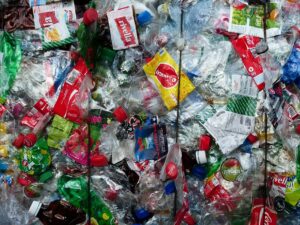Wasting waste: we must do better on recycling plastic
 15 Oktober 2020
15 Oktober 2020
According to a recent report by The PEW Trusts called Breaking the Plastic Wave, current recycling commitments will only reduce annual plastic flows to the ocean by 7%. We should be aiming to go way beyond this depressingly low forecast.
As their report indicates, the value of global investments in the plastic industry between 2021 and 2040 could be reduced from $2.5 trillion (±$800 billion) to $1.2 trillion (±$300 billion). To achieve this target will require a substantial shift of investment away from the production and conversion of virgin plastic.
Surely this is a wake-up call for all entities producing and using virgin plastics. They are now facing a transformational choice that could just tip the balance. Anyone who opts to unlock value from a circular economy that derives revenue from the circulation of materials rather than the extraction and conversion of fossil fuels will be game-changers in our race to authentic sustainability.
There is no one single solution. If we reduce plastic use we risk causing an imbalance as we up our production of other materials such as glass or paper that may increase CO2 emissions. We need to find a balance between improving recycling practices, expanding waste collection, and ensuring that disposal facilities prevent plastic leakage.
Whilst we are now seeing a surge of new enterprises focusing on doing just that, there is an unhelpful misconception currently pervading the industry that relates to sorting.
Sorting is not the solution
With the current focus on innovative sorting processes that can identify additional factors such as food-grade or non-food-grade besides the polymer, it is vital to emphasize that sorting alone will not solve our recycling challenges.
The fact is that sorting is only the first important step of the journey towards a true circular economy. It is obviously a vital facet of the entire process; however, we need to go beyond merely sorting our waste if we are to make any meaningful shift in the way we manage our short lived materials to minimize and reduce current waste levels.
Much more thinking needs to be dedicated to making products that can be recycled simply and productively by recycling businesses. This means eliminating “difficult to recycle” packaging and optimizing the composition, such as low or no pigmentation, mono construction through to readily removable adhesives and labels.

If we create multiple sub-categories of packaging in response to the perception that sorting will have the capacity to create narrower fractions of materials then the economics will diminish and issues of cross-contamination will increase.
As companies and businesses seek to avoid the forthcoming hefty plastic packaging taxes that are looming, sorting appears to be grabbing the headlines as the way forward. Instead, the debate needs to center around which type of complete recycling processes and products will deliver the best results.
Wasted waste
Ultimately, regardless of how waste is actually identified and sorted, we will still end up with a pile of well-sorted plastic that is of low value unless it can be properly re-used, and this requires cutting-edge extrusion, filtration and decontamination.
If we are to make better use of our plastic packaging waste we need to turn it back into high quality recycled mono-polymers that can be re-used in new products. Brand owners and retailers are desperately short of food-grade recycled plastic of every type.
Less virgin
Any organization involved in FMCG knows full well that they are going to have to drastically curb their dependence on virgin plastic if they are to comply with the new plastic packaging laws.
To achieve this will require having a vast and new supply of food-grade recycled plastics including PET, HDPE and Polypropylene (PP) to turn into the bottles, tubs, pots and trays they are using since these plastics are the largest volume plastics used globally.
Whether we opt for chemical markers (such as fluorescent marker based PRISMTM) or digital watermarks, the very fact that we can now enhance the sorting and identification processes is a key step in the right direction.
Half the solution
Decontamination is the next crucial phase, to be able to turn our well sorted waste into valuable recyclates such as food-grade rPP, food-grade rHDPE and food-grade PET.
Achieving the vision of near-zero plastic waste requires technological advances, brave new thinking, innovative business models as well as accelerating upstream innovation.
In the case of PP, it has taken 8 years of intense research and commercial trials to achieve a powerful and unique decontamination process for food-grade recycled PP. This has resulted in PPristineTM that is shortly going for EFSA and USFDA approval.
PPristineTM is in effect the missing link that will finally close the loop on food-grade recycled PP that has been “missing-in-action” to date. The NEXTLOOPP process is being launched in October 2020 to take PP out of the waste stream into the circular economy.
Unlocking the full value of our plastic waste will go a long way towards helping organisations honour their commitment to increase the level of recycled material they use in their packaging — better still this kind of coherent recycling strategy will have enormous impact on reducing post consumer waste.
We urgently need to focus on closing the plastic loop by taking each facet of the process from collection and sorting through to decontamination to ensure a transformational shift occurs.
It is imperative that we acknowledge we can start making paradigm changes right now with the technologies we already have at our fingertips and this must embrace the entire recycling process. If we are going to tip the balance in the right direction we need to change “business as usual” to avoid the worst consequences.
In Europe PP accounts for 10million t/yr with 40% (4Million t/yr) used for consumer packaging, which, largely goes un-recycled or to low value applications. Certainly the fact that EU legislation is soon to apply a €800/t charge for single use plastics with less than 30% recycled content should add to brand owners’ motivation to re-address their recycling commitments.
However, the process does not stop there. Otherwise, we will be wasting potentially valuable end of first-use materials.
The post Wasting waste: we must do better on recycling plastic appeared first on Sustainability Times.
